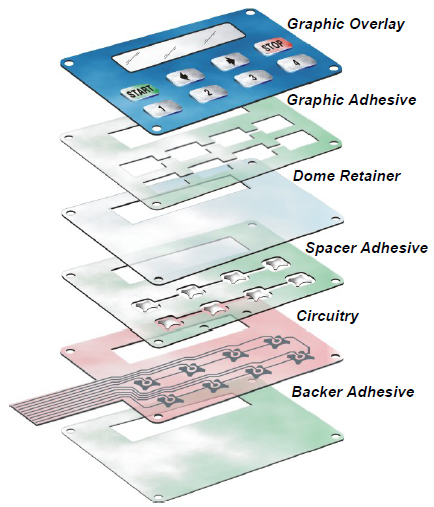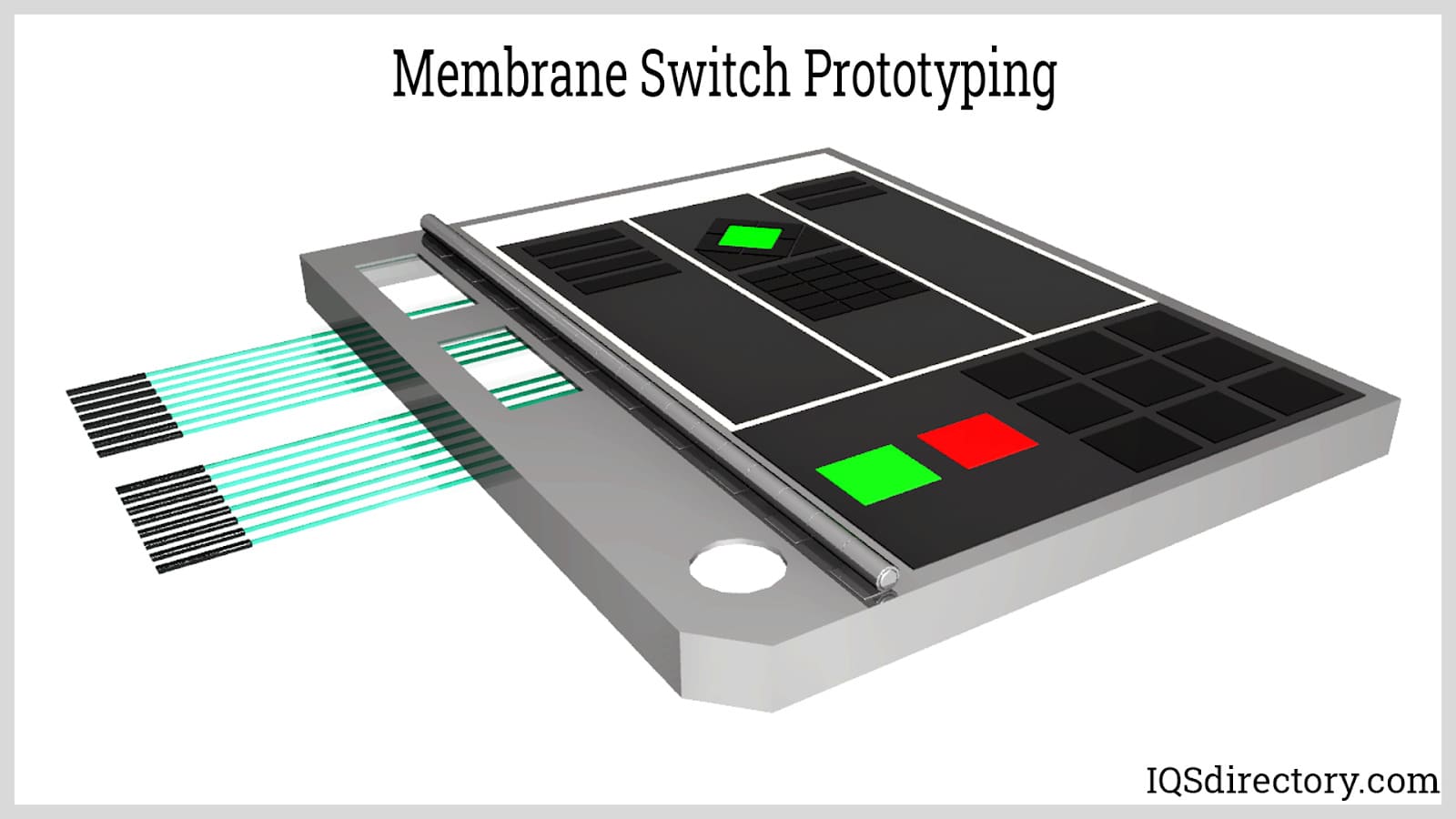Everything About Membrane Switch Over: Understanding Its Design and Capability
When you think concerning the control user interfaces in contemporary tools, membrane layer switches typically come to mind. Let's explore what sets membrane layer changes apart from various other control systems.
What Are Membrane Layer Switches?

Membrane layer switches can likewise be customized relating to form, size, and graphics, permitting makers to produce distinct user interfaces customized to certain items. In general, membrane layer switches play a significant role in boosting user experience throughout a large array of applications.
Just How Membrane Layer Changes Work
When you push a key on a membrane button, it triggers a simple yet effective device. The top layer, commonly made of adaptable material, lowers onto a conductive layer beneath it. This action bridges the void between conductive traces, completing an electric circuit. As quickly as the circuit closes, it sends a signal to the device's controller, which interprets your input.
You'll see that the tactile comments varies based on the button style, offering either a soft click or a much more obvious action. When you launch the key, the membrane layer returns to its initial placement, resuming the circuit and stopping the signal. This process takes place virtually instantly, ensuring a receptive user experience.
Membrane layer switches are preferred as a result of their resilience and resistance to dust and wetness, making them excellent for different applications, from home devices to medical devices. Recognizing this operation assists you value their widespread usage.
Trick Elements of Membrane Layer Switches
Comprehending the vital elements of membrane layer buttons is essential for realizing their capability and layout. At the core, you'll find the graphic overlay, which gives the aesthetic user interface for customers. Under that, there's a spacer layer that separates the circuit layers, guaranteeing that they don't make call up until pushed. The circuit layer is where the magic occurs; it includes conductive traces that complete the circuit when you push the switch. One more necessary element is the sticky support, enabling the button to stick to surfaces safely. Finally, the protective layer guards against environmental elements and wear, expanding the switch's life expectancy. Each component plays a considerable role in making certain dependable efficiency and customer interaction. By understanding these elements, you'll acquire understanding right into just how membrane switches operate and their value in different applications.
Products Utilized in Membrane Change Design
The efficiency and sturdiness of membrane switches over greatly rely on the materials utilized in their layout. You commonly run into polyester and polycarbonate as main substratums due to their excellent toughness and versatility. These materials resist scratches and chemicals, making them excellent for requiring atmospheres.
The conductive layers typically use silver or carbon, selected for their reliability and conductivity. membrane switch manufacturer. Silver gives superior performance, while carbon is a cost-efficient option. For the overlay, you may think about a matte or shiny surface, depending on your visual requirements and customer experience
Make specific to select adhesives that stand up to ecological variables like temperature and moisture. Picking the right products will guarantee your membrane layer button stands the test of time.
Design Considerations for Membrane Buttons
While creating membrane buttons, it's vital to take right into account numerous aspects that influence their performance and customer experience. Start by concentrating on the layout and switch size; make sure they're intuitive and very easy to navigate. Consider the tactile feedback you want to provide-- will customers need a noticeable click or a softer touch? Additionally, think of the materials you'll use, as they'll affect longevity and looks.
Do not forget the graphic design; clear labeling and color contrast are significant for presence. Confirm your style suits ecological aspects, like dampness or temperature level variations, which could affect performance. Remember the value of testing models with actual users to gather comments and make needed modifications. This repetitive process assists you improve the layout, validating it fulfills both practical and aesthetic demands efficiently. By meticulously thinking about these aspects, you'll develop a membrane layer switch that improves use and satisfaction.
Applications of Membrane Buttons
Membrane switches are flexible parts found in different applications, from commercial devices to customer electronic devices. You'll see their impact in equipments that call for sturdy interfaces and in devices that take advantage of sleek designs. Understanding these applications assists you appreciate the functionality and practicality of membrane layer buttons in everyday technology.
Industrial Tools Use
When you're looking to boost the capability of commercial devices, membrane buttons use a dependable service that combines longevity with user-friendly layout. These buttons are excellent for rough settings, offering resistance to dust, moisture, and chemicals. You'll find them in control panels for manufacturing machines, a/c systems, and medical tools, where precision and responsiveness are important. Their reduced profile indicates they fit flawlessly right into different equipment, saving valuable area Visit This Link while keeping convenience of use. With adjustable graphics and backlighting options, you can produce an user-friendly user interface for drivers, boosting effectiveness and security. Plus, their long life expectancy reduces upkeep costs, making them a wise financial investment for your industrial applications. Accept membrane layer buttons to streamline your procedures and improve overall efficiency.
Customer Electronics Integration
In the domain name of consumer electronics, membrane layer buttons play a necessary function in enhancing individual communication and device capability. Membrane layer switches also guarantee toughness and resistance to dirt and find more information moisture, prolonging the lifespan of your electronics. By choosing membrane buttons, you enhance not just the performance however also the style of your gadgets, making everyday communications smooth and enjoyable.
Benefits and Negative Aspects of Membrane Layer Switches
While membrane buttons use a variety of advantages, they likewise come with some downsides that you ought to think about. One considerable advantage is their portable layout, making them suitable for space-constrained applications.

Nevertheless, there are disadvantages. Membrane buttons can have a much shorter lifespan compared to mechanical buttons, particularly under hefty use. They can likewise be less responsive, which could influence individual comments throughout operation. If harmed, fixing them can be tough and typically needs total replacement. Ultimately, their sensitivity to extreme temperature levels and environmental conditions might restrict their efficiency in certain setups. Balancing these pros and disadvantages will assist you figure out if membrane switches are the best suitable for your task.
Frequently Asked Questions
How Much Time Do Membrane Changes Typically Last?
Membrane layer switches over commonly last in between 5 to 10 years, relying on use and environmental problems. You'll wish to evaluate Web Site variables like wear, exposure to wetness, and temperature changes to assess their longevity effectively.
Can Membrane Changes Be Customized for Specific Designs?
Yes, you can tailor membrane layer buttons to fit specific styles (membrane switch manufacturer). You'll have the freedom to choose colors, forms, and formats that match your task's demands, ensuring they blend perfectly with your overall aesthetic
What Is the Price Variety for Membrane Layer Switch Manufacturing?
The expense array for membrane button manufacturing commonly falls between $1 and $10 per system, depending upon elements like style complexity, quantity, and materials. You can get quotes from makers to discover the ideal choice.

Are Membrane Layer Changes Water-proof or Resistant?
Membrane buttons can be made to be water-proof or immune, depending upon materials used and construction approaches. If you require them for damp settings, assure you define those demands during the layout process.
How Do Membrane Switches Compare to Traditional Buttons?
Membrane layer buttons are normally thinner and more versatile than traditional switches, using a sleek style. They're typically simpler to clean up and incorporate, but might not give the responsive responses you're made use of to with mechanical alternatives.
Final thought
